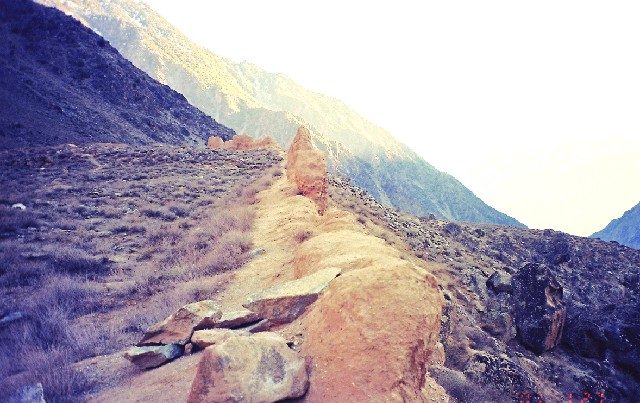
Apart from the remains of fortified villages and the ancient Buddhist monastery, there are also many historic wooden mosques in Darel valley which were studied by both Pakistani and Italian archaeologists.
Zulfiqar Ali Kalhoro
The Darel valley in Diamer district is known for its distinctive culture, history and heritage. It was in 2000 when I first visited the Darel valley as a part of my consultancy with the International Union for the Conservation of Nature (IUCN). As an ethnographer, I was engaged to study customary law in Gilgit-Baltistan (formerly the Northern Areas). Like other valleys of Gilgit-Baltistan, I visited the tribal valleys of Darel and Tangir for this purpose. During the research, I developed my interest in the culture and heritage of the Darel valley. I was so fascinated by the culture of Darelis that my subsequent years were spent collecting data on the history, culture and heritage of Darelis. I visited all the archaeological sites in the valley – and in doing so, documented the historic mosques and shrines (ziyarats) which were once venerated by Darelis before converting to the Deobandi school of thought.
The Darel valley is home to many historic sites which are found right from Gayal, the first village in the valley, to the last village of Yeshoot. One comes across the ruins of fortified settlements, fortresses, ancient shrines, monasteries etc on the hills that overlook the historic villages. The remains of the fortified settlements which are locally called Kot are vandalized by the local people in search of treasure. Many precious artifacts were found during illegal excavations and they were sold to antiquities collectors. The Raji Kot is the most vandalized site in the valley.
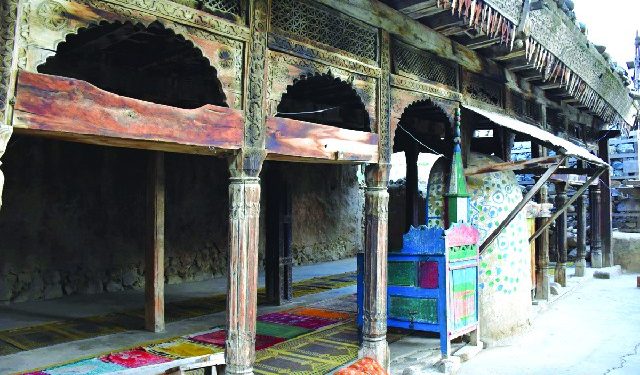
A majority of these fortified settlements are of the pre-Islamic era. Only a few are of the Islamic era. A prominent site consists of the remains of the Gumari fortress which is believed to have been built by Pakhtun Wali Khan. He ruled over Darel, Tangir, Harban, Sazin and Shatial from 1905 to 1917. He belonged to the Khushwaqte, the ruling family of Yasin, a branch of the dynasty of Chitral. The British called the Indus valley below Chilas and its tributary valleys –like Darel, Tangir, Harban, Sazin, Kandia and many other smaller valleys – Yaghestan, which meant ‘land of the free.’ No ruler before Pakhtun Wali Khan ever dominated these valleys. It was he who ruled the roost and exploited the rich resources of Darel and Tangir, inviting the Kakakhels of the Nowshera district and giving them a contract for timber in both the valleys.
Particularly ancient and famous are the remains of a Buddhist monastery, locally called Naukot, on a hill overlooking Phuguch village in Darel valley. The earliest source of information about the Buddhist monastery in Darel valley is by two Chinese pilgrims Faxian (Fa-hsien) and Xuanzang (Hsuan-Tsang). Faxian visited Darel about 403 AD on way to Udayana (Swat). On the way to Udayana, he also visited and mentioned the Buddhist monastery of Ta Li Lo or Darel valley and mentioned the carved wooden image of the Maitreya Bodhisattva. Later it was also visited by Chinese pilgrim Xuanzang, who also mentioned the Buddhist monastery in Ta Li Lo or Darel valley – which was an old and important seat of the government of Udayana Kingdom. They also narrated that there were many monks, all students of the Hinayana school. Sir Aurel Stein (d. 1943), who visited Darel valley during the rule of Pakhtun Wali Khan, also described the Buddhist monastery of Darel in his book Innermost Asia Vol. 1. He was the first European to visit Darel and Tangir who recorded the history and heritage of both the valleys in his book.
The earliest source of information about the Buddhist monastery in Darel valley is by two Chinese pilgrims Faxian (Fa-hsien) and Xuanzang (Hsuan-Tsang)
Apart from the remains of fortified villages and the ancient Buddhist monastery, there are also many historic wooden mosques in Darel valley which were studied by both Pakistani and Italian archaeologists. Some of the prominent mosques are located at Gayal, Phuguch, Birokot or Somigal Bala and Manikyala Bala. I have already written an article on the Gayal Mosque, which appeared on the 27th of November, 2020, in The Friday Times.
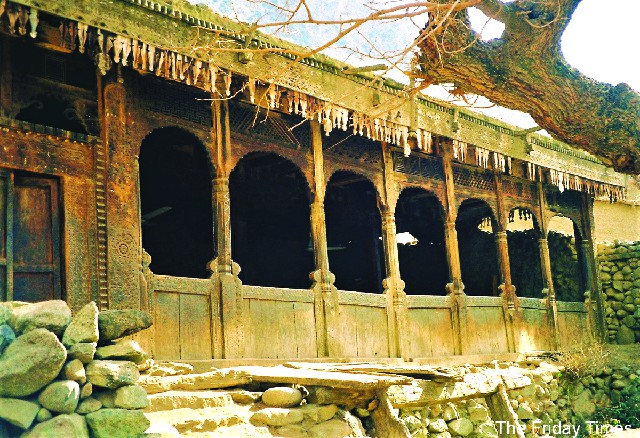
Apart from the Buddhist monastery, there also existed the historic wooden mosque and tombs in Phuguch village. The mosque was rebuilt in 2018. I visited Phuguch village first in 2000, later in 2001, 2009 and 2019 respectively. During my visits, I had conversations with local people regarding the oral history of the village, particularly about the mystics who came from Swat on a preaching mission to Darel valley.
The Phuguch mosque dated back to the eighteenth century. It was profusely decorated with floral and geometric designs. There was an ornately carved doorway way that led to the covered verandah of the mosque. The door jambs were engraved with floral and geometric designs. The most noticeable carvings on the door jamb were of the sun motif, which is also found on the pillars and doors of various wooden mosques in the Diamer district. The covered verandah of the Phuguch mosque had seven arched windows with grilled panels. The roof of the verandah stood on five pillars. There was also a hujra attached to the verandah. The entrance to the hujra was provided from the verandah. There was also the doorway to the main prayer hall. The roof of the main prayer hall rested on three square pillars.
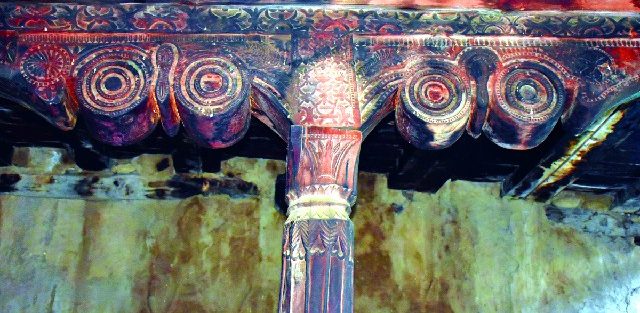
There is a wooden platform, locally called byak or kari, to the east of the mosque which is used for the namazis and also by the village council or Jirga. It is a tradition among Darelis to erect wooden platforms either near the mosque or on the bank of the river. Sometimes, these wooden platforms receive special attention so far as the decoration is concerned. One finds two types of platforms for the Jirga, the simple and the decorated. One of the most splendid wooden platforms in Darel valley is located in Birokot, Manikyala Bala and Pain. The distinctive features of these platforms are their ornamentation.
Apart from the mosque and Jirga platforms, there used to be wooden tombs of Shaheeds (martyrs), the mystics who came from Swat to preach Islam in the valley. These persons were killed by Darelis and later they repented and built a tomb over their graves. There are 7 graves of martyrs in Phuguch village: six are located in the village graveyard (jarat) and the seventh grave is located west of the village across the river at the foothill. The most popular shrine in Phuguch was of Shah Khel Baba. The wooden tomb was noted for its intricate wood carving. Stories of Shah Khel Baba were also recorded by Sir Aurel Stein in his book.
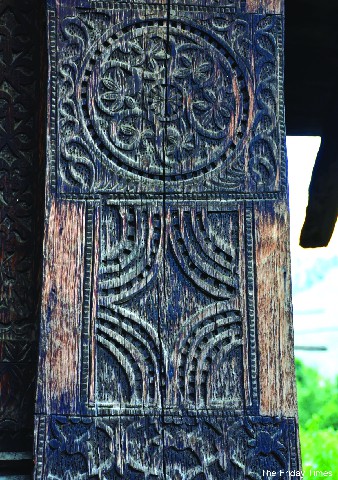
Apart from the wooden mosques of Gayal and Phuguch, the most imposing wooden mosque is located in Birokot, now called Somigal Bala. It is ornately carved. One enters the verandah through the western main doorway which is highly carved. It consists of a rectangular prayer chamber. In design, the mosque has the same system as at Phuguch insofar as the mihrab faces the verandah. Right in front of the mihrab, there is a huge square pillar decorated with floral and geometric designs. The flat roof of the prayer chamber rests on three central square pillars, none of which have bracket capitals. However, the flat roof of the covered verandah rests on five pillars. Three pillars are tapering and fluted, standing on a square base. They have double volute bracket capitals each encloses different motifs. Every architectural element of the mosque is tastefully decorated. There is also a Jirga platform attached to the wall of the mosque.
There was also a wooden mosque at Dodokot, now called Somigal Pain, which was also rebuilt. The wooden tomb over the grave of a mystic which was demolished a long time ago was the second most popular shrine (ziyarat) after the shrine of Shah Khel Baba at Phuguch. Sir Aural Stein visited both the shrines in his visit to Darel valley during the rule of Pakhtun Wali Khan. He provided photographs of both the shrines in his book Innermost Asia Vol.1.
Apart from the Phuguch and Birokot, the shrines of mystics were also found at Manikyala Pain. As mentioned earlier, these mystics came from Swat to preach Islam in the valley and most of them were killed by Darelis – and hence they are known as shaheeds. But they are not venerated by Darelis anymore. Their wooden enclosures and tombs are all gone now. Apart from Darel valley, shrines of mystics were also found in Tangir Valley. The most popular shrine was located in Lorakh village, which was demolished when the populace of the valley became Deobandis. It is said that the shrines of Babas (saints) of Phuguch village in Darel and Lorakh village in Tangir were the most popular shrines of both the valleys. Both shrines were visited by hordes of people every day and animals were slaughtered at both the shrines as mannat. This practice came to end when both Darelis and Tangirs discarded their old belief system of saint veneration and converted to the Deobandi School.
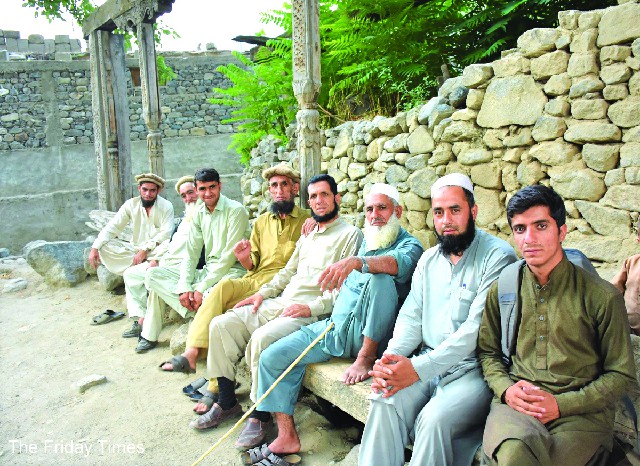
Apart from Birokot, there is the historic mosque at Manikyala Bala. Some renovations have been carried out in this mosque. Italian Professor Umberto Scerrtao, who surveyed the historic mosques of Darel, mentioned the labyrinth motif on the architrave of the door in the covered verandah of the Manikyala Bala mosque. He also noted the labyrinth motif on the pillars of several other mosques in Dir-Kohistan and Swat-Kohistan in his article Labyrinths in the Wooden Mosques of North Pakistan: A Problematic Presence which was published in East and West journal in 1983. The labyrinth motif also appears in rock art sites in upper Kohistan and Diamer districts. Shatial is the most famous rock art site where one finds two of the best engravings of the labyrinth on a rock.
There were also magnificent wooden mosques at Manikyala Pain and Yeshoot which have been rebuilt now.
Darel has much tourism potential: the concerned authorities should make concerted efforts in this regard and open a tourist center at Gumari to guide tourists. Alternatively, tourism authorities could base themselves at Chilas, headquarters of Diamer, and take the tourists to the valley to show them archaeological sites, historical mosques and carved wooden coffins.
_______________________
 Dr. Zulfqar Ali Kalhoro, an anthropologist, has authored 12 books including ‘Symbols in Stone: The Rock Art of Sindh’, ‘Perspectives on the art and architecture of Sindh’, ‘Memorial Stones: Tharparkar’ and ‘Archaeology, Religion and Art in Sindh’. He may be contacted at: zulfi04@hotmail.com
Dr. Zulfqar Ali Kalhoro, an anthropologist, has authored 12 books including ‘Symbols in Stone: The Rock Art of Sindh’, ‘Perspectives on the art and architecture of Sindh’, ‘Memorial Stones: Tharparkar’ and ‘Archaeology, Religion and Art in Sindh’. He may be contacted at: zulfi04@hotmail.com
Courtesy: The Friday Times Lahore